A total solar eclipse is a fairly rare phenomenon in the Sun-Earth-Moon system. There is no periodicity of their visibility at a specific point on the earth’s surface, and for the whole planet such phenomena can occur up to two during the year, although in some years (for example, in 2025) they do not happen at all. In 2024, a total eclipse of our sun is expected on April 8. Unfortunately, it is impossible to observe it from the territory of Ukraine and in the eastern hemisphere in general, with the exception of the Svalbard archipelago, where small partial phases will be visible at sunset. How and where can you see this beautiful phenomenon?
Recall that a total eclipse of our luminary occurs only when the apparent diameter of the Moon is larger than the solar one. The moon’s shadow has the shape of a long cone that crosses the earth’s surface almost with its tip, so the size of the “shadow spot” is small and rarely exceeds 250 km. It moves along the Earth at a speed from 700 m/s to almost a kilometer per second and “draws” a band of total phase, and only within its limits does the sky become dark enough for observers to see the brightest stars on it, and prominences and the solar corona around the Moon. Even when a small corner of our luminary remains uncovered, it “spoils the whole picture”, and such an eclipse is no longer considered total, but partial (in fact, annular eclipses are also a kind of partial). And scientists and astronomy enthusiasts try to get into this band.
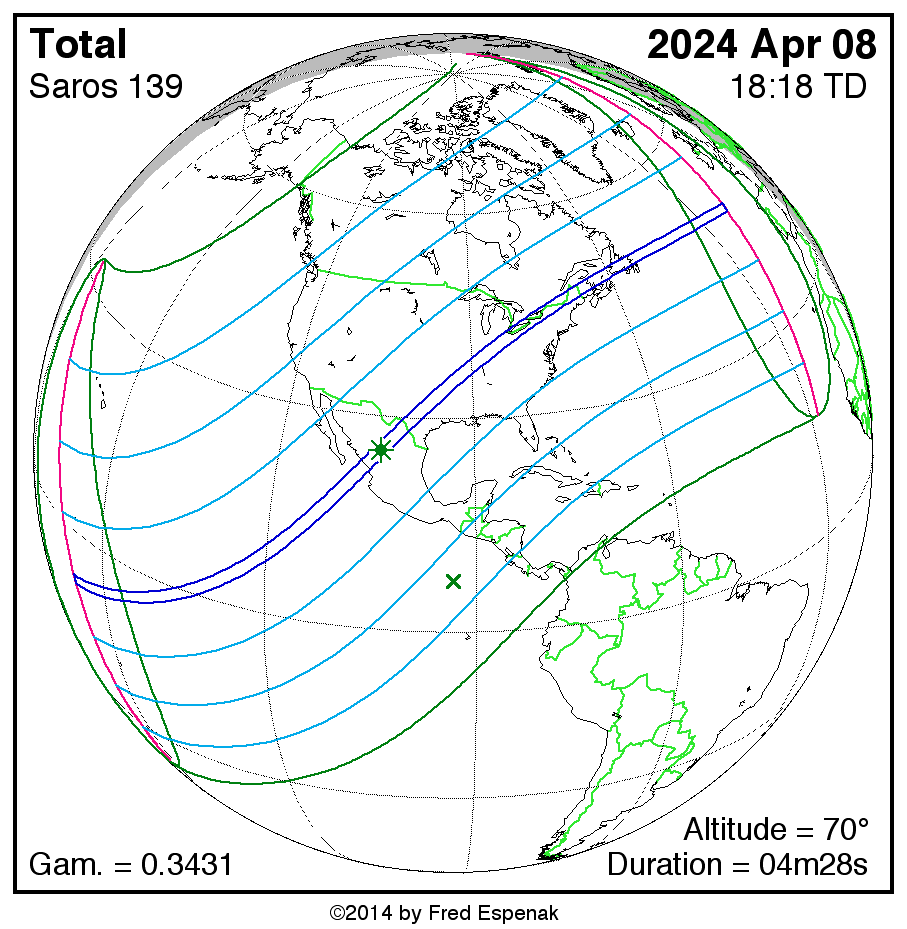
On April 8, 2024, the moon’s shadow will touch the Earth in the Pacific Ocean near Penrhyn Atoll (Cook Islands) and begin to move rapidly to the northeast. In about an hour and a half, it will cross the Pacific Ocean and cover the first landmasses — the islands of San Juanito and Maria Madre off the coast of Mexico. On the North American continent, it will enter the area of the Mexican city of Mazatlan. Not far from it, the total eclipse will reach its longest duration (4 minutes 28 seconds) — this will happen at a point with coordinates of 25°17.5′ north latitude, 104°07.2′ west longitude at 06:17:13 p.m. world time. Mexico City, the capital of the country, will see a partial phase of 0.79 magnitude with the Sun‘s height above the horizon of almost 77°, but of course, no solar corona will be visible there.
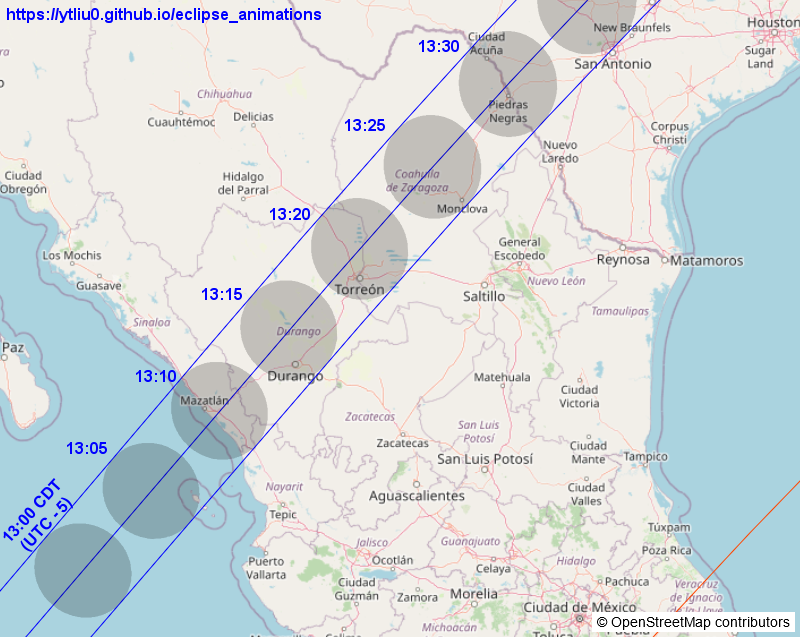
The shadow will approach the border between Mexico and the United States in 10 minutes and begin to move across the state of Texas. The northern part of the city of San Antonio, the capital of Austin, the million-plus cities of Dallas and Fort Worth will be in the total phase. Then this band will cross the states of Arkansas, Missouri, Illinois, and slightly “touch” Kentucky. In Indianapolis— the capital of Indiana, there will be a total eclipse lasting almost 4 minutes at a sun altitude of 53°. Then the “spot” of the shadow will enter the state of Ohio, and its northern half will cover Lake Erie and finally reach the territory of Canada at its southernmost point (Pele Island).
Moving along the extreme south of the province of Ontario (the northern edge of the full phase band will be a few kilometers from the waterfront of the largest Canadian city of Toronto), the moon shadow will pass in parallel through the American states of Pennsylvania and New York. Cloud forecasts for these places at the beginning of April are not very favorable, but if observers are lucky, one of them will be able to take impressive photos of the solar corona over Niagara Falls. Also, a total eclipse lasting up to two minutes will be visible in Montreal, Canada’s second largest city. Before leaving the American continent, the total phase band will “visit” the states of Vermont, Maine and New Hampshire, as well as the province of New Brunswick. Further east, with cloudless weather, which is rare here, a total eclipse will be visible on Prince Edward Island and Newfoundland. On the east coast of the latter, the maximum duration of the total phase will drop to 2 minutes 53 seconds.
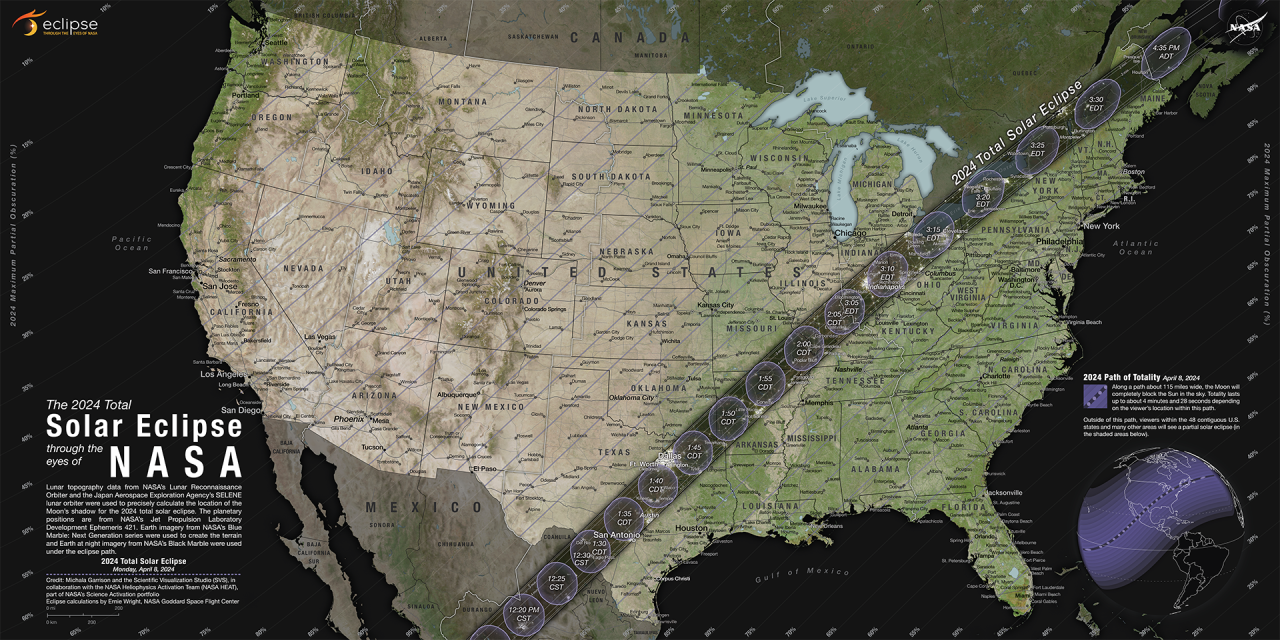
In the North Atlantic, the moon’s shadow will not meet any more islands and will leave the Earth’s surface at 07:55 p.m. at a point with coordinates 47°34.3 northern latitude, 19°53.2 west longitude, about 1100 km east of the peninsula of Brittany (France).
Partial phases of the eclipse, in which a large or smaller part of the solar disk will remain uncovered by the Moon, will be observed throughout North America (except Alaska), Panama and the far north of Colombia, the Caribbean Islands and the Canadian Arctic Archipelago, Hawaii, the Bahamas, Bermuda, the Azores, Iceland and Greenland, as well as — at sunset — in Ireland, Scotland, Madeira and the western Canary Islands. It is clear that the closer to the total phase band, the greater the partial one will be: for example, the lunar disk will cover the solar disk by 95% of the diameter of the latter for residents of Chicago, by 92% for New York, by less than 90% for Washington, and by only 60% for Los Angeles. It is also obvious that the smaller the phase, the shorter the duration of the eclipse from the first to the last contact (from the beginning of the Moon’s entry into the solar disk to the complete completion of its descent).
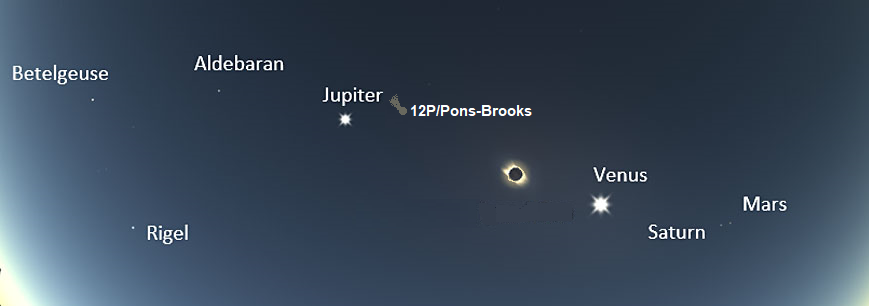
Those for whom total eclipse will occur in the complete absence of clouds will also be able to see bright star-shaped objects in the darkened sky. First of all, we are talking about planets visible to the naked eye. However, Uranus will still remain too weak for a “darkened” sky. Mercury will also be unlucky, which on April 8 will be close to the configuration of the lower conjunction, turning its unlit side to the Earth, and will look like a star slightly brighter than the 5th magnitude just 6° from the solar corona. Far from our luminary — about 35° to the right and below — Saturn and Mars will be located, both having a brilliance of the order of the first magnitude and forming a remarkable pair in the sky (the apparent distance between the planets will be only 1.5°). In the same direction, but at an elongation of 15°, a bright Venus will shine. Jupiter can be easily found to the left and above 30° from the Sun, and 6° to the right of it and 25° from the Sun, it is worth trying to find the Pons-Brooks comet — its brightness will increase to the 4th magnitude by that time. It is best to use binoculars with a large field of view and a magnification of 15-20 times.
Below, above the eastern horizon, Capella (α Aur), Aldebaran (α Taurus), the bright stars of Orion and Gemini will be visible. Observers in Mexico and Texas will still see Vega (alpha Lyrae) low above the horizon in the northwest, and for those who will observe in Arkansas or to the east, it will have time to disappear by the time of the total phase, and Procyon and Sirius will appear in the east. The faintest star visible to the naked eye is likely to be Deneb (alpha Cygnus).
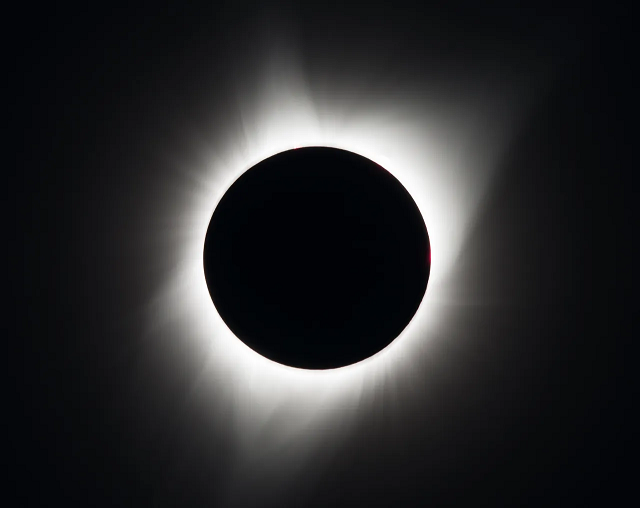
Interestingly, in southern Illinois and western Kentucky, a total solar eclipse was observed less than seven years ago — on August 21, 2017. Then the moon’s shadow passed through the United States from the Pacific to the Atlantic coast and “did not catch” any other country.
Earlier, we wrote in what conditions the conjunction of the planets with the Moon would be visible in April.
Follow us on Twitter to get the most interesting space news in time
https://twitter.com/ust_magazine


